Influence of Vibration and Ground Deformation on Historic Structures: Case Study
IF 1.4
4区 地球科学
Q2 GEOSCIENCES, MULTIDISCIPLINARY
引用次数: 0
Abstract
When discussing historic structures, a significant problem is how to preserve and protect these structures. The presented paper deals with some issues of the unfavourable impact of industrial activity on some historic structures. Long-term influences from the industrial activity are one of the common sources of damage observed in these structures. Due to the size and volume of such structures, they are characterized by very low resistance to vibration and ground deformations. At the same time, the high cultural and material value of historic structures necessitates their costly protection and repair. Knowing the origin of problems, one may take proper actions to protect them. This paper discusses two important types of impact typical for industrial areas, especially affected by mining, seismically induced vibrations and continuous ground deformations from underground extraction. The presented discussion is based on the case study examples of historical sites located in some industrial areas in the Czech Republic and Poland. They point to different sources of damage to those structures that may arise as well as a combined effect of mining-induced seismic events and land subsidence. The medieval Jeroným Mine represents an underground structure loaded with natural and technical seismicity. The paper also includes a short overview of the process of seismic loading evaluation and basic information about historic structures with respect to seismic standards and land surface subsidence caused by underground mining.振动和地面变形对历史建筑的影响:个案研究
在讨论历史建筑时,一个重要的问题是如何保存和保护这些建筑。本文讨论了工业活动对一些历史建筑的不利影响。工业活动的长期影响是这些结构中观察到的常见破坏来源之一。由于这种结构的大小和体积,它们的特点是对振动和地面变形的阻力非常低。同时,历史建筑具有很高的文化和物质价值,需要对其进行昂贵的保护和修复。知道问题的根源,就可以采取适当的措施来保护问题。本文讨论了工业地区典型的两种重要冲击类型,特别是受采矿影响的冲击,地震诱发的振动和地下开采引起的连续地面变形。所提出的讨论是基于案例研究的例子,历史遗址位于捷克共和国和波兰的一些工业区。他们指出,这些建筑物可能受到不同的破坏来源,以及采矿引发的地震事件和地面沉降的综合影响。中世纪Jeroným矿井代表了一个地下结构,承载着自然和技术地震活动。本文还简要介绍了地震荷载评价的过程,并从地震标准和地下开采引起的地面沉降方面介绍了历史建筑的基本信息。
本文章由计算机程序翻译,如有差异,请以英文原文为准。
求助全文
约1分钟内获得全文
求助全文
来源期刊

Acta Montanistica Slovaca
地学-地球科学综合
CiteScore
3.60
自引率
12.50%
发文量
60
审稿时长
30 weeks
期刊介绍:
Acta Montanistica Slovaca publishes high quality articles on basic and applied research in the following fields:
geology and geological survey;
mining;
Earth resources;
underground engineering and geotechnics;
mining mechanization, mining transport, deep hole drilling;
ecotechnology and mineralurgy;
process control, automation and applied informatics in raw materials extraction, utilization and processing;
other similar fields.
Acta Montanistica Slovaca is the only scientific journal of this kind in Central, Eastern and South Eastern Europe.
The submitted manuscripts should contribute significantly to the international literature, even if the focus can be regional. Manuscripts should cite the extant and relevant international literature, should clearly state what the wider contribution is (e.g. a novel discovery, application of a new technique or methodology, application of an existing methodology to a new problem), and should discuss the importance of the work in the international context.
 求助内容:
求助内容: 应助结果提醒方式:
应助结果提醒方式:


